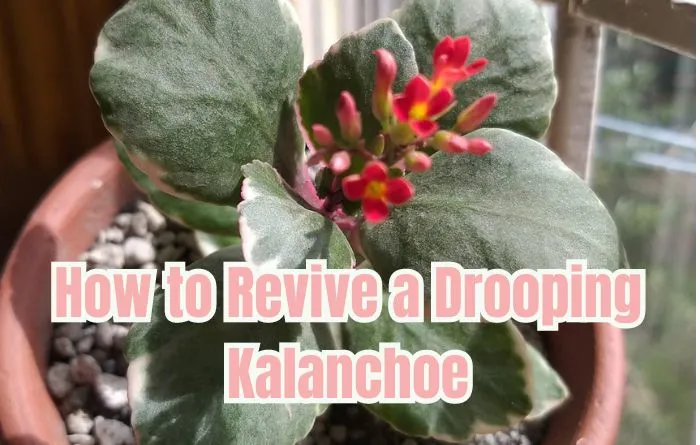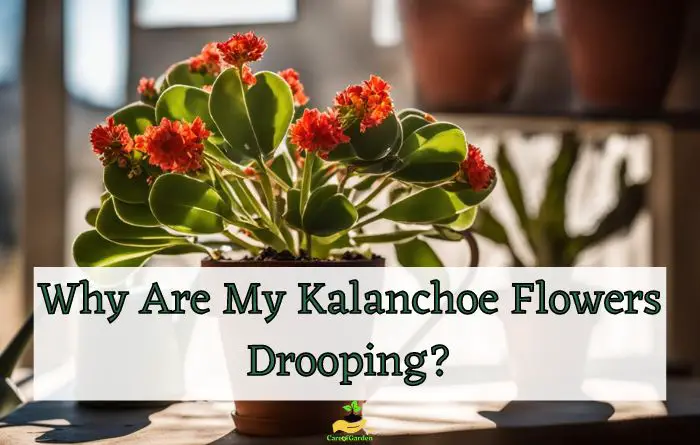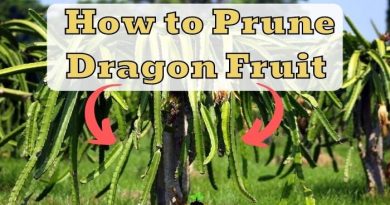Why Are My Kalanchoe Flowers Drooping? How to Revive Them
Are you noticing your kalanchoe flowers drooping and feeling concerned about their health? In this article, I will explore the common reasons for drooping kalanchoe flowers and provide you with practical tips to address the problem and restore your succulent’s vitality.
Kalanchoe flowers are drooping due to over-watering, under-watering, exposure to extreme temperatures, lack of sunlight, stress from repotting, poor soil quality, pests, diseases, or flower weight. Over-watering and under-watering can cause root issues, while temperature and light extremes stress the plant. Pests and diseases also put strain on it. Repotting may shock the plant temporarily. Poor soil lacks nutrients and good drainage for healthy roots and blooms. Flower weight itself can pull blooms down. Kalanchoe age or natural lifecycle may also influence drooping.
Causes of Kalanchoe Flowers Drooping
As a succulent owner, it is important to know why your kalanchoe flowers are falling. Here are some of the most common causes:
1. Over-Watering
Over-watering is the most common cause of kalanchoe flowers drooping. When the succulent receives excess water, the moisture level in the soil increases, leading to root rot, which affects the plant’s ability to absorb water and nutrients.
This can happen if you water your plant too often or if you leave it sitting in water. When the roots of your kalanchoe are constantly wet, they can’t get the oxygen they need to function properly. This leads to the flowers drooping.
Treatment
I always make sure the pot I use has drainage holes on the bottom to allow excess water to escape. If water is unable to drain out, it can accumulate in the soil and cause root rot from overwatering. Symptoms of root rot include drooping leaves and flowers.
To prevent overwatering issues, I allow the soil to dry out completely between waterings. Before watering, I check the moisture level by feeling the soil about an inch deep. If it still feels moist, I wait a few more days.
I also use a well-draining soil mix for succulents or cacti. These mixes let excess water drain away quickly instead of leaving the roots soaked.
By checking the soil moisture and choosing the right pot and soil, I can avoid overwatering my kalanchoe and keep its beautiful flowers upright.
2. Under-Watering
Underwatering is the second issue that is causing my Kalanchoe’s blossfeldiana flowers to droop. This occurs when I don’t water my kalanchoe plant frequently enough or when the pot lacks proper drainage. When the plant doesn’t receive adequate water, its flowers will start to wilt.
If I notice the flowers on my kalanchoe drooping, I check whether underwatering may be the cause. I ensure the pot has drainage to prevent standing water. If needed, I also move my succulent to an area with more sunlight. Sunlight can help the soil dry out between waterings.
Treatment
To water my kalanchoe effectively, I thoroughly soak the soil at each watering. This allows the soil to evenly moisten and the roots to absorb water and nutrients. I wait until the top inch of soil is dry before watering again.
By maintaining a consistent watering routine and providing good drainage, I keep my kalanchoe succulent well-hydrated. This prevents dehydration that leads to drooping flowers.
| Watering Tips | Effect on Kalanchoe Flowers |
|---|---|
| Allowing soil to dry out between waterings | Prevents overwatering, reduces the risk of root rot, and promotes healthy flower growth |
| Using well-draining soil | Improves water drainage and prevents waterlogged soil that can lead to drooping flowers |
| Avoiding overwatering | Prevents root rot and maintains a healthy moisture balance for the kalanchoe plant |
3. Exposure to Extreme Temperatures
High temperatures above 85°F can cause my kalanchoe flowers to wilt and droop. When subjected to intense heat, the plant struggles to retain moisture, leading to dehydration and weakened stems.
To keep my flowers upright, I make sure to provide adequate shade or relocate the plant to a cooler, shadier spot.
Conversely, temperatures below 60°F can also harm my kalanchoe’s blooms. Cold weather inhibits the kalanchoe succulent’s ability to absorb water and nutrients, resulting in wilted, drooping flowers.
It is crucial I protect the plant from frost and drafts by moving it indoors or insulating it during colder periods.
| Temperature | Effect on Kalanchoe Flowers |
|---|---|
| Above 85°F (29°C) | Wilting and drooping due to dehydration |
| Below 60°F (16°C) | Wilting and drooping due to hindered water absorption |
| 60°F to 85°F (16°C to 29°C) | Optimal temperature range for healthy kalanchoe flowers |
Treatment
To optimize my kalanchoe’s health and appearance, I aim to maintain temperatures between 60°F to 85°F. Sudden fluctuations in temperature can cause drooping.
Here are some tips for properly managing my kalanchoe’s temperature:
- During hot weather, I provide shade for my kalanchoe or relocate it to a cooler spot. This helps the plant retain moisture to prevent wilting flowers.
- In colder periods, I protect the plant from frost and drafts by moving it indoors or insulating it. Harsh colds can hinder water and nutrient absorption.
- I aim to consistently maintain temperatures between 60°F to 85°F. Fluctuations outside this range may cause falling blooms.
- To support stable temperatures, I place my kalanchoe away from heating or cooling vents where it could experience sudden changes.
4. Lack of Sunlight
Insufficient light is another reason why kalanchoe blooms may drop prematurely. These plants demand a good amount of sunlight to properly bloom.
If a succulent of mine seems to be dropping flowers, it makes me check if it could be lacking light. If so, I move it to a sunnier spot like a windowsill or supplement it with grow lights.
Treatment
Through experience, I’ve learned kalanchoes prefer bright, indirect light. I make sure to place them near windows that provide plenty of illumination without harsh direct rays.
| Light Condition | Recommended Duration | Optimal Placement of Kalanchoe |
|---|---|---|
| Bright, indirect sunlight | 6 or more hours | Next to a north or east-facing window |
| Direct sunlight | Gradually increase exposure | Partial sunlight to start, then gradually move to a location with more direct sunlight |
| Artificial grow lights | 12 to 14 hours | Position the lights about 12 inches above the plant |
5. Stress from Repotting
If the stress from repotting is too severe, the kalanchoe may turn brown and drop some of its flowers as a protective measure. By dropping extra energy-draining blooms, it can focus on strengthening its root base first before flowering again.
When it’s time to repot my Kalanchoe plant into a new container, I know I need to be careful not to cause too much stress. Even though repotting helps renew the soil and give the roots more room to grow, it can still shock my plant if I’m not gentle.
The process of untangling the roots from the old pot and settling them into new soil disrupts my Kalanchoe’s system. Its roots are what absorb water and nutrients to keep the colorful flowers thriving. Too much disturbance can throw things off balance.
Treatment
To minimize this stress, I’m very gentle when untangling roots and use new, nutrient-rich potting soil. I also give my succulent extra care like shade and water after repotting so it can recover smoothly. With the right handling, its flowers will stay vibrant!
In the days following repotting, my plant needs to adjust to its new home. During this adjustment period, it may struggle a bit as the roots re-establish. The kalanchoe has to work hard to continue supporting those blooms on its stems.
6. Poor Soil Quality
As an expert gardener, I know my kalanchoe’s beautiful blooms depend on optimal soil.
If the soil isn’t rich or well-draining enough, it makes it hard for my kalanchoe’s roots to get what they need. Roots take in water and nutrients through the soil to nourish those vibrant flowers.
But in poor soil, the roots don’t have the right balance. They may not be able to take up enough water when the soil is too dry. Or too much moisture in heavy, non-draining soil can actually deprive them of air.
When my kalanchoe’s roots are struggling, it impacts the whole plant. The flowers won’t receive sufficient support and may start looking brown and droopy.
Sometimes the plant will drop extra blooms as a way to conserve its energy for root health. By lightening its load, it can focus on thriving in the problematic soil.
Treatment
To keep my kalanchoe blooms perky, I use nutrient-rich, well-draining potting mix and replace the soil periodically to maintain optimal growing conditions for strong, happy roots!
| Soil Condition | Soil Requirements for Kalanchoe to Flower |
|---|---|
| Well-draining | Kalanchoes are succulents and prefer soil that drains well to prevent root rot from overwatering. Good drainage is essential. |
| Sandy | The soil mix should contain sand or perlite to ensure it drains quickly while still holding enough moisture. |
| Nutrient-rich | The soil needs nutrients like nitrogen, phosphorus and potassium to support healthy growth and flowering. Aged compost adds nutrients. |
| Acidic pH | Kalanchoes thrive in soil with a slightly acidic pH between 6.0-6.5. The pH helps control availability of nutrients. |
| Loose texture | The soil should not be dense or packed down. A loose, airy texture allows for good drainage and root penetration. |
| Moisture-retentive | Despite needing drainage, the soil also has to retain enough moisture between waterings to prevent drying out. |
7. Pests
As someone who has battled both mealybugs and aphids on kalanchoe plants, I can say with confidence that these sap-sucking pests are the primary culprits when it comes to kalanchoe blooms dropping prematurely.
Mealybugs
Mealybugs, as the name suggests, are small, soft-bodied insects that seem to secrete a fluffy white waxy substance. They feed on plant sap from leaves, stems, and flowers.
A heavy infestation of mealybugs can cause leaves to yellow and drop, and blooms to shrivel up and fall off the plant. I have found that applying treatments with insecticidal soap helps control mealybugs.
Aphids
Aphids are another sap-sucking pest that affects kalanchoe. They are tiny, soft-bodied insects that come in various colors like black or green.
If you spot these small insects on the flowers or stalks, it’s a sign the plant is dealing with an aphid infestation. Too many aphids stealing away the plant’s nutrients through constant feeding can stress it out, resulting in blooms prematurely dropping.
Treatment
Physical pest control is the first line of defense. I inspect plants closely and remove any visible pests by hand or with an alcohol-soaked cotton swab.
Horticultural oil sprays work well for both soft-bodied pests. I apply a neem or insecticidal oil mix as directed on the labels. The oils smother pests and coat their exoskeletons to inhibit feeding and reproduction. This source mentions using horticultural oils.
Sticky traps near plants help monitor for pests and catch some before they reach foliage. I place yellow sticky cards between and around kalanchoe to intercept flying insects like aphids.
As a last resort, systemic insecticides can provide longer-term protection. I carefully follow labels when using a systemic like imidacloprid, applying it as a soil drench to be absorbed by roots and leaves. This is poisonous to pests but less risky for people and pollinators.
8. Diseases
Powdery mildew
Powdery mildew is a fungal infection that develops a white, powdery appearance on the leaves and stems of the plant. It thrives in environments with low air circulation and humidity.
The fungus saps nutrients from the plant, weakening it. Heavily infected kalanchoe may drop their blooms and lower leaves as a result.
Treatment
When I notice the telltale white powder developing, I know it’s time to take action to avoid further spread and bloom loss. I remove any affected growth and increase airflow around plants.
Spraying a fungicide specifically for powdery mildew as directed on the label usually does the trick. It’s important to continue treatments as new growth appears.
Root rot
Root rot is a common woe for Kalanchoe plants. It’s caused by excessive moisture around the roots, usually due to overwatering or poorly draining soil.
When roots rot, they can’t efficiently absorb water and nutrients, causing the entire plant to weaken. As a result, blooms may droop or wither.
Treatment
To prevent root rot, ensure your Kalanchoe’s pot has good drainage. Water the plant only when the top inch of soil is dry, and always empty the saucer to avoid water accumulation.
Gray mold
Another disease I’ve battled is botrytis blight, also known as gray mold. It shows up as fuzzy gray spots on blooms and stems. Soggy soil from overwatering and poor ventilation creates ideal conditions for its spread. Blooms touched by botrytis quickly shrivel up and drop off.
Treatment
At the first sign of gray fuzz, I remove and discard any moldy plant parts. Improving drainage and allowing more space between plants are critical for prevention. Fungicides containing streptomycin or copper can also help curb an active botrytis infection.
9. Flower Weight
No matter how sturdy, a kalanchoe stem has its limits on how much it can bear up top. If a long period of flowering results in especially weighty blooms, I notice the stems slowly drooping under the pressure. It seems the last straw that causes flowers to finally let go.
Treatment
To prevent this, I’ve learned to stake overwhelmed Kalanchoe to take the strain off their stems. A sturdy stake is like an extra set of strong shoulders to help hold the flower-filled head high.
Alternatively, I may trim back heavy stems so the plant puts energy into branching out with multiple strong new growths better able to carry the floral load.
By being aware of how flower-laden kalanchoes can become top-heavy, I can take steps to avoid beauty bringing them down and ensuring the blooms last as long as possible.
10. Kalanchoe Age (Normal Flower Life Cycle)
The age of the kalanchoe plant itself could also influence bloom longevity in my experience. Mature specimens may not keep flowers perky for as long as when younger. Their blooms similarly signal the close of their natural cycle through drooping.
Through years of growing kalanchoes, I’ve observed their blooms typically follow a natural cycle. After about six weeks of displaying vibrant flowers, the blooms will often start to droop downwards.
This signals to me that the flowers have come to the end of their lifespan and are readying to complete their life process. Rather than seeing this as a problem, I understand it as the plant naturally redirecting its energy.
If I notice older Kalanchoe flowers drooping in this fashion, I know it’s generally nothing to worry about. These plants have likely been blooming for a long stretch. It’s normal for some blooms to gracefully wilt as the flowering phase draws to a close.
By recognizing blooms drooping after around six weeks or as the plant ages is standard, I don’t feel the need to intervene.
How to Revive a Drooping Kalanchoe

1. Water consistently and Improve drainage
To revive drooping kalanchoe flowers, it is crucial to implement proper watering techniques. The right approach to watering can help restore the plant’s health and vibrancy.
Here are some key tips and techniques:
- Allow the soil to dry out. Overwatering is a common cause of drooping kalanchoe flowers. To prevent this, allow the soil to dry out between waterings. Check the moisture level by inserting your finger into the soil about an inch deep. If it feels dry, it’s time to water.
- Use well-draining soil. Kalanchoe plants thrive in well-draining soil that allows excess water to flow out. Ensure the pot has drainage holes, and use a mix of potting soil and perlite or sand to improve drainage.
- Avoid overwatering. While it’s important to keep the soil moist, avoid overwatering the kalanchoe plant. Water thoroughly until water drains out of the bottom of the pot, but don’t let it sit in standing water.
2. Provide and Optimize Light Conditions
Proper light conditions play a crucial role in preventing drooping kalanchoe flowers. To optimize light conditions for your plant, follow these key guidelines:
- Provide adequate sunlight. Kalanchoe plants thrive in bright, indirect light. Place your plant in a location where it can receive at least 6 hours of indirect sunlight daily. This will promote healthy growth and prevent drooping flowers.
- Gradually introduce direct sunlight. If your kalanchoe has been indoors or in a low-light environment, it’s important to acclimate it to direct sunlight gradually. Sudden exposure to intense sunlight can cause leaf burn and further lead to drooping flowers. Start by placing the plant in a spot with partial sunlight and gradually increase the exposure as the plant adjusts.
- Consider artificial grow lights. If you don’t have access to sufficient natural light, you can use artificial grow lights to supplement the light needs of your kalanchoe. LED grow lights are a great option as they provide the necessary spectrum of light for optimal plant growth. Place the lights about 12 inches above the plant and keep them on for around 12 to 14 hours a day.
3. Use Proper Soil and Fertilize Weekly
To revive drooping kalanchoe flowers, proper soil and fertilization techniques are important to restore your suculent health and vigor.
Here are some key tips:
- Improve drainage. When repotting a droopy kalanchoe, I use a well-draining potting mix to prevent roots from sitting in soggy soil. I combine organic potting soil with perlite or gravel to allow excess water to easily drain away.
- Check nutrient levels. I test the soil pH and check if nutrients may be lacking using a meter. Kalanchoes thrive with a slightly acidic pH of 6-7 and nutrients from an all-purpose fertilizer or compost tea.
- Fertilize weekly. To nourish a stressed plant back to health, I fertilize weekly during the growing season with a dilute solution of water-soluble 20-20-20 or 5-10-5 fertilizer. This boosts the soil with nitrogen, phosphorus and potassium.
4. Inspect for pests or disease
Pests and diseases can also cause drooping Kalanchoe flowers. Check your succulent regularly for signs of pests or disease, such as yellowing leaves or spots on the leaves.
Here are three of my top tips:
- Isolate and prune. If pests or diseases are present, isolate the plant and prune away severely infected leaves and stems. This removes the source.
- Use horticultural oil sprays. For common kalanchoe pests like mealybugs and aphids, I spray the plant thoroughly with neem or horticultural oils. This suffocates the pests.
- Treat powdery mildew promptly. If I notice the white fuzzy mold powdery mildew, I act fast with a copper fungicide spray or baking soda solution. Early treatment prevents spread.
How to Stimulate New Flower Growth on Kalanchoe
If your kalanchoe flowers are drooping, here are some techniques I’ve found to be effective in stimulating new flower growth on my kalanchoe plants:
- Pruning off spent flowers is key. By deadheading the old blooms down to the main stem or leaves, I remove any distractions and signals to the plant that it’s time to focus energy on producing more flowers.
- Fertilizing weekly during the spring and summer growing seasons provides plenty of nutrients in the soil to support new floral development. I use a dilute water-soluble fertilizer tailored for blooming houseplants that is high in phosphorus.
- Increasing light exposure is another important factor to encourage new flower growth. I move kalanchoe receiving less than 6 hours of direct sunlight closer to a south-facing window. More light hours encourages profuse budding. If you cannot provide enough natural light, you can supplement with artificial light.
- I make sure the soil has a chance to dry out between waterings. Wet feet can cause issues, so I allow the top inch to dry before watering thoroughly to keep my kalanchoe slightly on the drier side.
- Ensuring adequate airflow around plants also promotes strong, compact growth. I rotate pots weekly so all sides receive circulation which deters pests and diseases that could hamper reblooming.
- Finally, make sure you are watering your kalanchoe correctly. Kalanchoes are drought tolerant, but they do need some water to bloom well. Allow the soil to dry out completely between watering. Water deeply, and then allow the excess water to drain away. Do not allow your kalanchoe to sit in water, as this can lead to root rot.
Conclusion
In conclusion, drooping kalanchoe flowers can be a result of several issues. Underwatering, overwatering, extreme temperatures, old flowers, and bacterial infections are common causes of drooping kalanchoe flowers. The early implementation of rectifying solutions should enable you to return your kalanchoe’ flowers to their previous un-droopy stature.
Frequently Asked Questions
Overwatering can cause root rot and prevent proper oxygen uptake, resulting in drooping kalanchoe flowers. Adjusting the watering schedule, allowing the soil to dry completely between waterings, and ensuring proper drainage can resolve this issue.
High temperatures above 85°F (29°C) can cause wilting and drooping, while temperatures below 60°F (16°C) can be detrimental to kalanchoe flowers. Providing a suitable temperature range and avoiding temperature fluctuations can prevent drooping flowers.
Proper watering techniques, including allowing the soil to dry out between waterings, using well-draining soil, and avoiding overwatering, can help revive drooping kalanchoe flowers and promote plant health.
Providing adequate sunlight, at least 6 hours of indirect light daily, can prevent drooping kalanchoe flowers. Gradually introducing the plant to direct sunlight and using artificial grow lights can also help maintain a compact and non-drooping appearance.
Understanding the various causes and implementing the appropriate solutions, such as proper watering, optimizing light conditions, managing temperature, and taking proactive measures against pests and diseases, are key to maintaining healthy and non-drooping kalanchoe flowers.




